Design requirements for a Residential Sprinkler System?
Provincial, local and national building codes along with the National Fire Protection Association (NFPA) code 13D governs the design and installation guidelines for installing a residential fire sprinkler system in one and two family dwellings.
It is not the intention of this web page to encourage the home owner to undertake the design of a sprinkler system. Rather, it is our intention to provide the consumer with a better understanding of what is required to complete such a project.
Each residential sprinkler system must be hydraulically calculated to ensure that the sprinklers will operate properly in a fire to put enough of the white stuff (water) on the red stuff (fire). To operate properly a sprinkler must meet a minimum flow of 0.05 US gallons per minute per sq. ft. of coverage area. For example, one type of sprinkler at a spacing of 5.5M X 5.5M (18' x 18') requires a flow of 64.4 L/Min (17 US gpm) @ 107.8 kPa (15.6 psi) for each of two sprinklers.
NFPA 13D requires a maximum of two sprinkler flow which should be effective to combat a typical residential fire; therefore to obtain the total flow you will double the required flow of one sprinkler which is 64.4 L/Min X 2= 129 L/Min (34 US GPM). Hydraulic calculations, which are usually done by a computer software program, must deduct for all friction losses through the pipe, fittings, meters, backflow and valves from the water supply to the two most remote sprinklers in the home. If this first step is not carried out properly by a qualified engineer or sprinkler designer, the system may fail in a fire scenario.
As you can see, this is not a simple process and should only be done by a qualified sprinkler designer or professional engineer.
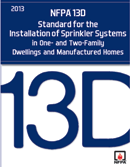
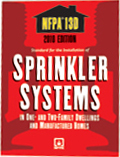
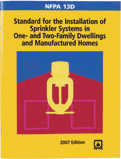
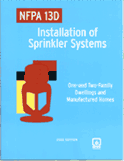
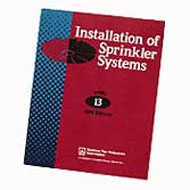
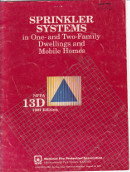
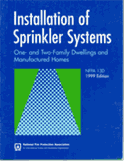 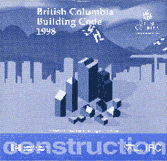
One-at-a-time Activation?
One-at-a-time activation means that only the sprinkler closet to the heat source of approximately 68�C/155�F or higher will activate the sprinkler. Smoke does not affect a sprinkler.
A popular misconception is that all the sprinklers release water at the same time. This is not true on any residential sprinkler system. This popular misconception only happens in the movies and gives the viewer a grossly exaggerated concept of how sprinklers operate.

Who Should Install Fire Sprinkler Systems?
Only qualified fire protection contractors utilizing qualified fire sprinkler installers should install fire sprinkler systems. Most, if not all provinces in Canada issues a �Certificate of Qualification� to licensed sprinkler and fire protection installers. As the life saving and property protection record of automatic fire sprinklers has become recognized and accepted by the general public, there has been a rush by unscrupulous individuals and companies to cash in on the industry. The practices of these firms and their unqualified workforce have produced disastrous results in many cases. Consult with your local Fire Department, Building Inspector, Workers Compensation Board and the Better Business Bureau in your area before choosing a contractor. Obtain references and be sure to check them out carefully. Be sure to obtain proof of Liability Insurance and WCB coverage from your contractor before any work is started.
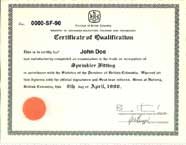 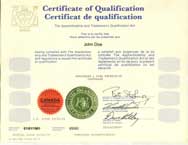
(Sample BC License is pictured left, sample Ontario license pictured right.)
|




